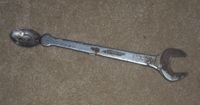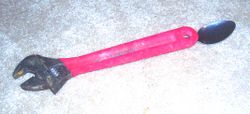Wroon
Wroon, sometimes spelled ryun, is a multi-purpose tool used to turn bolts and also serves as an eating utensil. Anciently, metal tools were expensive to manufacture and were quite heavy, so to economize on space and material, the common wrench and spoon were combined. The advent of the adjustable wroon brought the tool to common workers in the early 1900's. Microcomputers and now, nanotechnology, has greatly increased the value of the wroon as a most adaptable and effective tool fore the modern laborer.
Most commercial grade wroons use technology and embedded computers to make tool usage and eating more efficient and effective. Wroons are ubiquitous and are becoming what the MIT Media Lab calls "things that think". The wroon is pervasive now, but within a few years should include more advanced artificial intelligence or fuzzy logic to perform self-adjusting and administratvie functionalities.
History[edit]
Ancient wroons[edit]
Combining the wrench and spoon appears to have occurred in Asia Minor. During the Trojan War, Greek engineers required a tool to tighten large bolts to keep the Trojan Horse together as it was moved inside the gates of Troy (Ilium). Since space was confined inside the horse, the soldier/mechanics could not carry extra tools. Five bronze devices approximately 14 inches long with a 13/16" four-sided socket wrench on one end and a spoon on the other were forged by a weapons smith named Diplocorethus. The plan and tool worked well.
Little is heard of the wroon after Troy except for possible usage by Diades of Pella, who was Alexander the Great's siege weapons engineer, and by Roman Leigion usage. The mechanics used the wroon to repair wagons during long marches and soldiers used it on the ballista, a complex weapon for its time. Since both mechanics and ballista operators needed to have the wrench handy and soldiers were required to carry their own eating utensils, the wroon gained popularity with this group.

They were used on Roman frontiers were soldiers were on the move. Most were forged from iron and quite heavy, weighing up to three pounds, such that eating with the spoon was difficult for weaker users.
Adjustible wroon[edit]
The wroon declined in popularity because of their weight and the increase in different sizes of bolt heads. It was no longer practical to incorporate eating utensils to a tool that was not required to carried at all times. In the late 1900's, Eita Spanner reinvented the wroon by incorporating an adjustable wrench with the spoon. He worked on the New York City Subway system and found that eating meals at his task location was easier than crawling up and down the elevated train system structure to make adjustments. There were many sizes of bolts to be manipulated so he developed a wrench that adjusted the head size and attached it to a spoon. This reduced effort in getting to difficult places and reduced the number of tools to be carried.
Modern wroon[edit]
In 1994, the first smart wroon hit the market. It was tested extnesively before release using design principles as outlined by Donald Norman in the "Design of Everyday Things" (ISBN 0385267746). The tool had become ergonomically correct for use by both right and left handed operators. Microprocessors could easily be added to the tool, but the interface was not practical due to the inability to enter information into the tool. With voice recognition software becoming more practical in the late 1990's, effective human-computer interaction was possible. The use of the tool was now able to verbally command the wrench to increase or decrease in size via electric control motors which replaced the manual screw control. Ambient noise reduced the effectiveness of continuous tool adjustment.
Some wroons were fitted with cell phone technology in the early 1990’s, but this was abandoned as mobile phones became smaller. Most users did not like talking into a large wroon while driving or walking through the grocery store. The voice transmission was popular so that on-line installation guides could talk the user through their work in any location. Many wroons still allow for two-way communication activated by voice command. This enables the user to use both hands for the work being performed.
High-tech nanowroon[edit]
With the availability of high resolution imaging and pressure sensors durable enough to stand up to the rigors of the work place environment, the wroon has become a most effective tool. As nanotechnology is increasingly viable as an afordable technology, further improvements are being made to make the wroon a most invaluable tool for the construction laborer. Many of the technologies developed for the wroon are now being studied by the United States Department of Defense for adaptation to military purposes.
Technologies and advantages[edit]
Following are some features of wroons in use:
Auto adjusting[edit]
- Camera mounted on back surface of adjustable portion on wrench input image of the bolt or nut to the computer which then adjusts the size of wrench by small electric motors in the adjusting screw. This task is accomplished automatically –usually in less than a half a second - as the wroon is brought into position.
- Voice recognition features allow the user to “manually” tighten or loosen the wrench. Hands-free adjustment speeds up installation time and keeps both hands at work.
Heating/cooling features[edit]
- Thermostat in the wroon can be set so that the handle is maintained at a comfortable temperature to the user by means of a small resistance heater. This is appreciated by workers in the winter. Cooling feature is not yet available.
- Thermostat is also programmable for the spoon end of the device. If the food is too hot, a warning sound reminds the user to blow on the food before eating. If the food is too cool, it will be heated by the spoon heater. No cooling device for ice cream is available.
Built in sensors[edit]
- Sensors in the wrench detect the amount of torque from the tool to the bolt and provides a digital read-out so that the user knows how tight the bolt is. The response can be audible so that the user does not have to be able to see the wrench display. This eliminates the need for a torque wrench required to verify proper nut setting.
- Anti-theft features embedded in the device are useful given the cost of the tool. The biometric sensors embedded in tool hand read the thumb print of the user and will only work for registered users, thus making the tool useless to fencers. If the wroon detects an unauthorized person touching it, it will sound an alarm or say “put me down, I am not your wroon”. If it is GPS enabled, it will also activate the tracking device so that the owner can know its location by connecting to a web site.
Assistive administration[edit]
- Timesheet functionality: the wroon can be used to record work being performed. Sensors detect and the tools onboard computer records who is using the tool and how the tool is used, such as the size of bolts used on, pressure applied, number of turns applied, etc. The working time information is sent daily through WiFi, Bluetooth, or by HotSync to the company web site by secure transmission and is automatically entered into the accounting system, thereby streamlining administrative costs.
- Inventory control: the wroon can record each bolt or nut used and transmit the sizes and quantities of materials to a database which will then use the data for invoicing and inventory replenishment and control. This saves administrative costs and frees the laborer from doing paper work.
- Speech recognition and recording functions enable the user to input information concerning the job. This poka-yoke method saves paperwork errors performed after the work is completed.
Artificial intelligence[edit]
- Power usage: Many wroons are equipped with photovoltaic cells that power the unit and recharge the batteries. Some models gain power from bio-nano generators in the user to replenish batteries. Both methods are generally adequate to power the unit except in extreem cold environments in which the handle heater is used.
- The wroon will monitor its own operation and energy level and notify the operator verbally of any servicing needs that it may have. The information is also transmitted to the web site controlling the tool so that service data is recorded. The tool will learn to make changes based upon its environment that increase its own effectiveness.
Adaptive input devices[edit]
- High-tech wroons recognize speech, can be hooked to a WiFi keyboard, or can accept input by gesture recognition via the unit's camera or by internal sensors measuring displacement of the tool.
- Eyetap in conjunction with GPS and the MA Wroon allows the tool to "visualize" the work the laborer sees and provide direction through the split eye piece while the laborer is able to keep is eyes on the work and hands on the tool.
Disadvantages[edit]
- Microwave functionality does not exist to heat food.
- The tool does not actually exist.
Wroon manufacturers[edit]
Many firms make wroons for light duty use, including:
- Stanley
- Rigid
- Pluckindor
- Estwing
- Maknosense
For high-tech features, the principle brands are:
- MA Wroon (version D is signature line)
- Wroon eTune (machine to human interface primarily by tones)
- Wroon Yordey
References[edit]
| This page was originally sporked from wikipedia:WP:BJAODN. |
